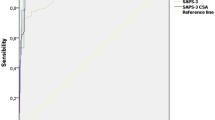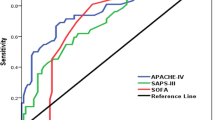Abstract
Objective
The aim of the present study was to validate the Simplified Acute Physiology Score II (SAPS II) and 3 (SAPS 3), the Mortality Probability Models III (MPM0-III), and the Cancer Mortality Model (CMM) in patients with cancer admitted to several intensive care units (ICU).
Design
Prospective multicenter cohort study.
Setting
Twenty-eight ICUs in Brazil.
Patients
Seven hundred and seventeen consecutive patients (solid tumors 93%; hematological malignancies 7%) included over a 2-month period.
Interventions
None.
Measurements and main results
Discrimination was assessed by area under receiver operating characteristic (AROC) curves and calibration by Hosmer–Lemeshow goodness-of-fit test. The main reasons for ICU admission were postoperative care (57%), sepsis (15%) and respiratory failure (10%). The ICU and hospital mortality rates were 21 and 30%, respectively. When all 717 patients were evaluated, discrimination was superior for both SAPS II (AROC = 0.84) and SAPS 3 (AROC = 0.84) scores compared to CMM (AROC = 0.79) and MPM0-III (AROC = 0.71) scores (P < 0.05 in all comparisons). Calibration was better using CMM and the customized equation of SAPS 3 score for South American countries (CSA). MPM0-III, SAPS II and standard SAPS 3 scores underestimated mortality (standardized mortality ratio, SMR > 1), while CMM tended to overestimation (SMR = 0.48). However, using the SAPS 3 for CSA resulted in more precise estimations of the probability of death [SMR = 1.02 (95% confidence interval = 0.87–1.19)]. Similar results were observed when scheduled surgical patients were excluded.
Conclusions
In this multicenter study, the customized equation of SAPS 3 score for CSA was found to be accurate in predicting outcomes in cancer patients requiring ICU admission.



Similar content being viewed by others
References
Soares M, Caruso P, Silva E, Teles JMM, Lobo SMA, Friedman G, Dal Pizzol F, Mello PVC, Bozza FA, Silva UVA, Torelly A, Knibel M, Rezende E, Netto JJ, Piras C, Castro AS, Ferreira BS, Réa-Neto A, Olmedo PB, Salluh JIF (2009) Characteristics and outcomes of patients with cancer requiring admission to intensive care units: a prospective multicenter study. Crit Care Med 38:9–15
Taccone FS, Artigas AA, Sprung CL, Moreno R, Sakr Y, Vincent JL (2009) Characteristics and outcomes of cancer patients in European ICUs. Crit Care 13:R15
Darmon M, Azoulay E (2009) Critical care management of cancer patients: cause for optimism and need for objectivity. Curr Opin Oncol 21:318–326
Staudinger T, Stoiser B, Mullner M et al (2000) Outcome and prognostic factors in critically ill cancer patients admitted to the intensive care unit. Crit Care Med 28:1322–1328
Azoulay E, Alberti C, Bornstain C, Leleu G, Moreau D, Recher C, Chevret S, Le Gall JR, Brochard L, Schlemmer B (2001) Improved survival in cancer patients requiring mechanical ventilatory support: impact of noninvasive mechanical ventilatory support. Crit Care Med 29:519–525
Soares M, Salluh JIF, Spector N, Rocco JR (2005) Characteristics and outcomes of cancer patients requiring mechanical ventilatory support for >24 h. Crit Care Med 33:520–526
den Boer S, de Keizer NF, de Jonge E (2005) Performance of prognostic models in critically ill cancer patients—a review. Crit Care 9:R458–R463
Schellongowski P, Benesch M, Lang T, Traunmüller F, Zauner C, Laczika K, Locker GJ, Frass M, Staudinger T (2004) Comparison of three severity scores for critically ill cancer patients. Intensive Care Med 30:430–436
Soares M, Fontes F, Dantas J, Gadelha D, Cariello P, Nardes F, Amorim C, Toscano L, Rocco JR (2004) Performance of six severity-of-illness scores in cancer patients requiring admission to the intensive care unit: a prospective observational study. Crit Care 8:R194–R203
Sculier J-P, Paesmans M, Markiewicz E, Berghmans T (2000) Scoring systems in cancer patients admitted for an acute complication in a medical intensive care unit. Crit Care Med 28:2786–2792
Soares M, Salluh JI (2006) Validation of the SAPS 3 admission prognostic model in patients with cancer in need of intensive care. Intensive Care Med 32:1839–1844
Berghmans T, Paesmans M, Sculier JP (2004) Is a specific oncological scoring system better at predicting the prognosis of cancer patients admitted for an acute medical complication in an intensive care unit than general gravity scores? Support Care Cancer 12:234–239
Guiguet M, Blot F, Escudier B, Antoun S, Leclercq B, Nitenberg G (1998) Severity-of-illness scores for neutropenic cancer patients in an intensive care unit: Which is the best predictor? Do multiple assessment times improve the predictive value? Crit Care Med 26:488–493
Groeger JS, Lemeshow S, Price K, Nierman DM, White P, Klar J, Granovsky S, Horak D, Kish SK (1998) Multicenter outcome study of cancer patients admitted to the intensive care unit: a probability of mortality model. J Clin Oncol 16:761–770
Le Gall J-R, Lemeshow S, Saulnier F (1993) A new simplified acute physiology score (SAPS II) based on a European/North American multicenter study. JAMA 270:2957–2963
Moreno RP, Metnitz PGH, Almeida E, Jordan B, Bauer P, Campos RA, Iapichino G, Edbrooke D, Capuzzo M, Le Gall JR, SAPS 3 Investigators (2005) SAPS 3—From evaluation of the patient to evaluation of the intensive care unit. Part 2: Development of a prognostic model for hospital mortality at ICU admission. Intensive Care Med 31:1345–1355
Higgins TL, Teres D, Copes WS, Nathanson BH, Stark M, Kramer AA (2007) Assessing contemporary intensive care unit outcome: an updated Mortality Probability Admission Model (MPM0-III). Crit Care Med 35:827–835
Benoit DD, Vandewoude KH, Decruyenaere JM, Hoste EA, Colardyn FA (2003) Outcome and early prognostic indicators in patients with a hematologic malignancy admitted to the intensive care unit for a life-threatening complication. Crit Care Med 31:104–112
Levy MM, Fink MP, Marshall JC, Abraham E, Angus D, Cook D, Cohen J, Opal SM, Vincent JL, Ramsay G (2003) 2001 SCCM/ESICM/ACCP/ATS/SIS International Sepsis Definitions Conference. Crit Care Med 31:1250–1256
Hanley JA, McNeil BJ (1982) The meaning and use of the area under receiver operating characteristic (ROC) curve. Radiology 143:29–36
Hosmer DW, Lemeshow S (2000) Applied logistic regression, 2nd edn. Wiley, New York
DeLong ER, DeLong DM, Clarke-Pearson DL (1988) Comparing the areas under two or more correlated receiver operating characteristic curves: a nonparametric approach. Biometrics 44:837–845
Metnitz PGH, Moreno RP, Almeida E, Jordan B, Bauer P, Campos RA, Iapichino G, Edbrooke D, Capuzzo M, Le Gall JR, SAPS 3 Investigators (2005) SAPS 3–From evaluation of the patient to evaluation of the intensive care unit. Part 1: Objectives, methods and cohort description. Intensive Care Med 31:1336–1344
Depuydt PO, Benoit DD, Roosens CD, Offner FC, Noens LA, Decruyenaere JM (2010) The impact of the initial ventilatory strategy on survival in hematological patients with acute hypoxemic respiratory failure. J Crit Care 25:30–36
Peek N, Arts DG, Bosman RJ, van der Voort PH, de Keizer NF (2007) External validation of prognostic models for critically ill patients required substantial sample sizes. J Clin Epidemiol 60:491–501
Zhu B-P, Lemeshow S, Hosmer DW, Klar J, Avrunin J, Teres D et al (1996) Factors affecting the performance of the models in the Mortality Probability Model II system and strategies of customization. A simulation study. Crit Care Med 24:57–63
Acknowledgments
We are indebted to the Instituto Nacional de Câncer, especially the Department of Clinical Research, and CNPq, for all their support. This study was supported by Instituto Nacional de Câncer. Dr. Soares and Dr. Bozza are supported in part by individual research grants from CNPq.
Conflicts of interest statement
None.
Author information
Authors and Affiliations
Corresponding author
Additional information
On behalf of the Brazilian Research in Intensive Care Network, BRICNet.
Electronic supplementary material
Below is the link to the electronic supplementary material.
Appendix
Appendix
Participatingcentersandinvestigators.Bahia: Hospital Português (José Mário Meira Teles). Distrito Federal: Hospital Santa Luzia (Marcelo de Oliveira Maia). Espírito Santo: Vitória Apart Hospital (Cláudio Piras). Maranhão: Hospital São Domingos, São Luís (José Raimundo Araújo de Azevedo, Widlani Sousa Silva) Minas Gerais: Hospital Mater Dei, Belo Horizonte (Frederico Bruzzi Carvalho). Pará: Hospital Porto Dias, Belém (Leila Rezegue, Rômulo Nina Paes). Paraná: Hospital de Clínicas, UFPR (Álvaro Réa Neto, Nazah C M Youssef). Pernambuco: Hospital de Clínicas, UFPE (Michele Maria Gonçalves de Godoy, Cláudia Ângela Vilela de Almeida, Roberto Barreto Campello). Piauí: Hospital de Terapia Intensiva, Teresina (Patrícia M. Veiga de C. Mello, Lina Melo). Rio de Janeiro: Instituto Nacional de Câncer, Hospital do Câncer I (Márcio Soares, Jorge I. F. Salluh); Instituto Nacional de Câncer, Hospital do Câncer II (José Jorge Soares Netto, Alexandre de Marca; Rodrigo Hatum; Frederico Muller; Pedro Tibúrcio Nagles; Wlademir Gonzalez); Hospital de Clínicas de Niterói (Paulo César Pereira de Souza, Cláudio Monteiro, Darwin Prado, Moyzés Damasceno); Hospital Mario Lioni, Duque de Caxias (Paulo C. P. Souza, Pedro Paulo Galhardo, Guilherme Nossar); Hospital Pasteur (Bruno da Silva Ferreira, Vicente Cés de Souza Dantas); Hospital Samaritano (Aline Castro, Ricardo Lima); Hospital CardioTrauma (Marcos Freitas Knibel, Robson Dantas Santana); Clínica São Vicente (Arthur Vianna, Alessandra Alves); Hospital São Lucas (Marcos Freitas Knibel, Eduardo Xavier). Santa Catarina: Hospital São José, Criciúma (Felipe Dal-Pizzol, Cristiane Ritter). São Paulo: Hospital A. C. Camargo (Pedro Caruso, Valdelis Novis Okamoto, Lúcio Souza dos Santos); Fundação Pio XII, Hospital do Câncer de Barretos (Ulysses V. A. Silva, Rosana D. S. Almeida, Richard S. P. Silva); Hospital Sírio Libanês (Luciano C. Pontes de Azevedo, Guilherme P. Schettino); Hospital Israelita Albert Einstein (Eliezer Silva, Alexandre Biasi Cavalcante, Miquéias Martins Lima Silva); Hospital de Base, Faculdade Regional de Medicina de São José do Rio Preto (Suzana Margareth Ajeje Lobo); Hospital do Servidor Público Estadual (Ederlon Alves de Carvalho Rezende). Rio Grande do Norte: Hospital Unimed Natal (Érico de Lima Vale). Rio Grande do Sul: Santa Casa de Misericórdia de Porto Alegre, Pavilhão Central (Gilberto Friedman, Jorge Amilton Hoher); Santa Casa de Misericórdia de Porto Alegre, Hospital Santa Rita (André Peretty Torelly).
Rights and permissions
About this article
Cite this article
Soares, M., Silva, U.V.A., Teles, J.M.M. et al. Validation of four prognostic scores in patients with cancer admitted to Brazilian intensive care units: results from a prospective multicenter study. Intensive Care Med 36, 1188–1195 (2010). https://doi.org/10.1007/s00134-010-1807-7
Received:
Accepted:
Published:
Issue Date:
DOI: https://doi.org/10.1007/s00134-010-1807-7




